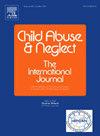Analysis of longitudinal patterns of child maltreatment reports in the United States
IF 3.4
2区 心理学
Q1 FAMILY STUDIES
引用次数: 0
Abstract
Background
Child maltreatment is a continuous and prevalent issue, and victims of maltreatment often suffer adverse effects well into adulthood. Since child maltreatment rates tend to be clustered geographically and temporally, intervention programs are best implemented at a local level, targeting local risk factors for sustained and effective reduction over time.
Objective
Quantifying geographic variation in child maltreatment rate trajectories can help states identify local risk factors to guide program development and resource allocation.
Participants and setting
National child maltreatment data from 2011 to 2020 from the National Child Abuse and Neglect Data System (NCANDS) was used to quantify child maltreatment rates (overall and substantiated) over time.
Methods
Latent trajectory analysis was conducted to identify groups of states in the United States that share distinct temporal patterns of child maltreatment rates. Child maltreatment data was linked to the American Community Survey data to obtain community-level characteristics.
Results
Three groups of states with distinct child maltreatment trajectories were identified: 43 states with stable trajectory, 4 states with increasing number of reports over time, and 5 states with decreasing reports over time. Although states with a stable trajectory had some characteristics associated with higher socioeconomic status, such as lower percentage of families below poverty level, and lower percentage of unemployed laborers, there was not a consistent trend in socioeconomic characteristics between the three groups.
Conclusions
Our results indicate there to be three groups of states with distinct child maltreatment trajectories, with majority of the states following a stable trajectory over time. There was not a consistent trend in socioeconomic characteristics between the three groups. While the results do not allow us to draw firm conclusions about socioeconomic characteristics associated with maltreatment trajectories, it does provide data-driven evidence for the existing assumption of a national average maltreatment trajectory.
美国儿童虐待报告的纵向模式分析。
背景:儿童虐待是一个持续和普遍的问题,虐待的受害者往往遭受不良影响,直到成年。由于儿童虐待率往往在地理上和时间上聚集在一起,干预方案最好在地方一级实施,针对当地的风险因素,随着时间的推移持续有效地减少。目的:量化儿童虐待率轨迹的地理差异可以帮助各州识别当地的风险因素,以指导项目制定和资源分配。参与者和环境:使用来自国家儿童虐待和忽视数据系统(NCANDS)的2011年至2020年的国家儿童虐待数据来量化一段时间内的儿童虐待率(总体和证实)。方法:进行潜在轨迹分析,以确定在美国具有不同的儿童虐待率的时间模式的州组。儿童虐待数据与美国社区调查数据相关联,以获得社区水平的特征。结果:确定了三组具有不同儿童虐待轨迹的州:43个州的轨迹稳定,4个州的报告数量随时间增加,5个州的报告数量随时间减少。尽管轨迹稳定的州具有与较高社会经济地位相关的一些特征,例如低于贫困水平的家庭比例较低,失业劳动者比例较低,但三个群体之间的社会经济特征趋势并不一致。结论:我们的研究结果表明,存在三组具有不同儿童虐待轨迹的州,其中大多数州随着时间的推移遵循稳定的轨迹。三组之间的社会经济特征没有一致的趋势。虽然研究结果不能让我们得出与虐待轨迹相关的社会经济特征的确切结论,但它确实为现有的全国平均虐待轨迹假设提供了数据驱动的证据。
本文章由计算机程序翻译,如有差异,请以英文原文为准。
求助全文
约1分钟内获得全文
求助全文
来源期刊

Child Abuse & Neglect
Multiple-
CiteScore
7.40
自引率
10.40%
发文量
397
期刊介绍:
Official Publication of the International Society for Prevention of Child Abuse and Neglect. Child Abuse & Neglect The International Journal, provides an international, multidisciplinary forum on all aspects of child abuse and neglect, with special emphasis on prevention and treatment; the scope extends further to all those aspects of life which either favor or hinder child development. While contributions will primarily be from the fields of psychology, psychiatry, social work, medicine, nursing, law enforcement, legislature, education, and anthropology, the Journal encourages the concerned lay individual and child-oriented advocate organizations to contribute.
 求助内容:
求助内容: 应助结果提醒方式:
应助结果提醒方式:


